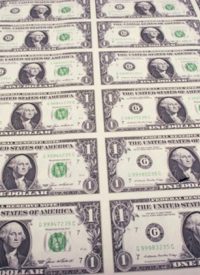
National Review, the putative voice of political conservatism, continues to flack for the Federal Reserve and Fed chief Ben Bernanke’s latest round of money magic known as "quantitative easing," or QE2.
In a December 1 column at National Review Online entitled "The Conservative Case for QE2," David Beckworth notes that "QE2 has many conservatives worried. They are concerned that these staggering increases in the monetary base have the potential to unleash a 1970s-type inflation and put the country on the path to economic ruin."
Beckworth acknowledges that the Fed had already vastly expanded the money supply in QE1:
After increasing the monetary base — currency in circulation and bank reserves — by about $1.2 trillion over the last two years, the Fed has decided to expand it again, by another $600 billion.
Beckworth seems surprised that conservative commentators and Republican legislators are alarmed by this profligacy. They are confused, he says.
"One reason for this confusion," suggests Beckworth, "is a failure by some conservative commentators to understand the real purpose of QE2. It is not solely about lowering interest rates, increasing bank reserves, and encouraging bank lending, though all of those will occur. Rather, it is about fixing a spike in the demand for money that has significantly hampered spending."
Conservatives must be aware, says Beckworth, that "if it works according to plan, QE2 will promote conservative principles." Really? How so? Only the Fed, he avers, can play the savior role needed to kick-start the economy into a "virtuous cycle" needed for recovery.
The Fed’s "virtuous cycle"?
Beckworth asserts:
A virtuous cycle would take hold and push the economy back toward full employment. But this virtuous cycle is not taking off because creditors are still hanging on to their money balances. What is needed to kickstart this cycle is an entity powerful enough to incentivize all the creditor households and firms to start spending their money simultaneously.
Enter the Federal Reserve. It alone has the ability to provide these incentives through its control of monetary policy.
Amazingly, Beckworth contends that the Fed’s multi-trillion-dollar expansion (a reported $8.95 trillion through the Fed’s newly established Primary Dealer Credit Facility, PDCF, since 2008) has been too tight-fisted.
"The fact that total current-dollar spending has remained depressed for so long means that the Federal Reserve has failed to do its job and effectively has kept monetary policy too tight," says Beckworth.
"So how does QE2 promote conservative principles?" he asks. "It does so," Beckworth claims, "by reducing the likelihood of further government spending on the economy." In the strange universe occupied by Beckworth and the neoconservatives at National Review, central planning and command policies by the Fed are classified as "market-based" economics.
"It is possible the current criticism aimed at the Federal Reserve will make it more timid in implementing QE2," says Beckworth. "Conservatives should not let this happen. They should throw their support behind the Federal Reserve while encouraging it to refine QE2 by tying the policy to explicit rules. Conservatives, especially, need QE2 to work."
Heaven forbid that the Bernie Madoffs who operate with impunity and immunity at the Fed should grow timid!
Bernie Madoff, "Helicopter Ben," and Buckley’s Heirs
This is not the first time that National Review has come to the aid of the Fed and Bernanke, who earned the nickname "Helicopter Ben" for his advocacy of "helicopter drops" of money into the economy. Of course, the money drops through QE1 and QE2 have vastly exceeded anything the Fed could hope to carry out even with the Pentagon’s entire helicopter fleet; what the Fed — and National Review — are pushing is the equivalent of conscripting every C-5 and C-130 cargo plane for a continuous round-the-clock money drop, with the key targets being Goldman Sachs, Citigroup, and other favored Wall Street friends.
When Rep. Ron Paul and other constitutionalists nearly succeeded in getting Congress to force an audit of the Fed this past summer, National Review Online featured an op-ed by Josh Barro ("Mend the Fed") that argued instead in favor of Sen. Bernie Sanders’ watered-down one-time audit, which would focus only on the "emergency" bailouts, a small portion of the Fed’s overall activities. Barro is aghast at efforts to "End the Fed," claiming that it is necessary institution.
In November, National Review again came to the defense of the Fed with articles by senior editor Ramesh Ponnuru ("Conservatives and QE2" and "More on QE2").
In their convoluted rationalizations for QE2, the writers at National Review have adopted "Fedspeak" or "Greenspeak," which former Fed chief Alan Greenspan (a favorite guru of the National Review crowd) boastfully described as "purposeful obfuscation" and "destructive syntax."
However, as we noted recently ("Faux Conservatism: Fox Gets It Wrong"), this is entirely in keeping with the pseudo-conservatism known as neoconservatism promoted by National Review’s founder William F. Buckley, and the oxymoronic "Big-Government Conservatism" supported by National Review veteran Fred Barnes.
Mark Thornton at the Ludwig Von Mises Institute, a free-market think tank, cuts through the Fedspeak, Greenspeak, and NationalReviewspeak with refreshing clarity. He writes:
Quantitative easing is simply printing more money. Normally the Federal Reserve buys government bonds passively to maintain its interest-rate target. With quantitative easing the Fed aggressively buys government bonds and other securities in large quantities.
So how does the Federal Reserve print money? First, it buys government bonds and other financial securities from big New York City banks. It pays for these bonds with newly created electronic money, using computers to change the records of the banks’ accounts at the Fed. If the banks want paper dollars, Federal Reserve Notes, the Department of the Mint at the U.S. Treasury prints and sends crisp new dollars to the Federal Reserve which forwards them to the banks.
People with inside information, or well-informed guesses can make tons of money off this process. Some bond traders and big banks are making a killing off of QE2.
Robert P. Murphy, also of the Ludwig Von Mises Institute, goes deeper into the subject in "QE2 and the Alleged Deflation Threat."
Remedial Econ 101
However, the neocons at National Review and their Bernanke-bedazzled sisters at The Weekly Standard, Fox News, and the Wall Street Journal seem to be impervious to genuine free-market analysis of the Fed’s destructive policies. They and others afflicted by Greenspanism and Bernankeism may profit from a Hans Christian Andersen-style approach which simply and starkly points out that "the Emperor has no clothes." That is the splash in the face that the animated video by Xtranormal, "Quantitative Easing Explained," brilliantly provides.
It should be mandatory viewing for all economists, economics professors — and writers at National Review.
Related articles:
Fed Data Reveals Trillions in Bailouts to Big Foreign Banks
$Trillion Bailout of Euro, Greece Shows Need to Audit the Fed
Fed Manipulations in the Crosshairs
Taking Delight in Deception: Greenspan’s “Purposeful Obfuscation”



